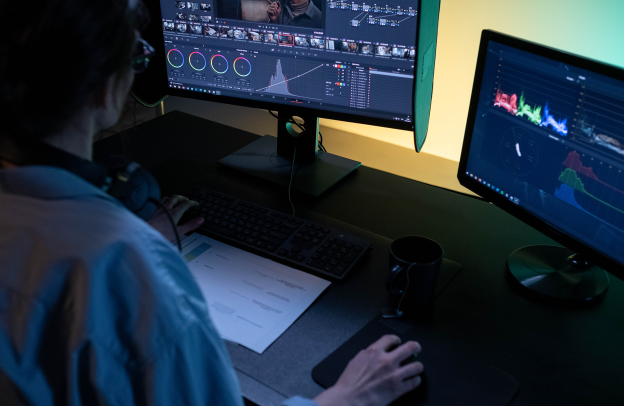Collaborations and Networking: How to Build a Creative Ecosystem That Can Fuel Your Business

Do you want to learn about collaboration and networking? You are in the right place. In the world of creative entrepreneurship, the myth of the lone genius persists, but the truth is, that no creative work exists in isolation. Your ideas, innovations, and artistic expressions may be born in solitude, but their impact is shaped by the people, relationships, and communities that surround you.
Want to learn more about storytelling? Start by downloading the first chapter of The Storytelling Mastery.
Collaboration and networking are the cornerstones of a sustainable creative business. Not only do they open doors to new opportunities, but they also create an ecosystem where your creativity can thrive, evolve, and expand.
In this article, we will look at some of the fundamentals of collaborations and networking in creative entrepreneurship. By the end, you should understand what is even meant by collaborations and networking, the advantages, finding the Right Collaborators and Partners in your creative business, building a community around your creative work, and much more.
What Are Collaborations and Networking in Business?
At its core, according to an article, “All about Networking in Business”, available on the CPD website, Business networking is about creating mutually beneficial connections. Always remember that.
It needs to be pointed out that, networking in business goes beyond mere socializing and small talk. Instead, you need to see it as a purposeful-driven initiative aimed at forging relationships that can lead to collaboration, partnerships, and access to valuable resources.
Why should you care about business collaboration? Well, consider that organizations that strategically connect and collaborate reap numerous benefits. Andrew Carnegie, a visionary in his time, aptly described teamwork as: “The ability to direct individual accomplishments toward organizational objectives. It is the fuel that allows common people to attain uncommon results.”
By fostering collaboration, businesses, and purpose-driven entrepreneurs can harness the collective strengths of their teams, driving innovation and achieving remarkable outcomes. With that out of the way, let’s talk more about the benefits of collaboration in the creative industry.
The Power of Collaboration in the Creative Industry
Whether you’re an artist, designer, writer, or musician, you know that your craft flourishes when influenced by diverse perspectives. The sharing of ideas, skills, and resources fosters innovation, enabling you to explore new avenues you might not have ventured into alone.
Consider the success stories of famous collaborations in creative industries. The partnership between Steve Jobs and Jony Ive, the designer behind Apple’s most iconic products, shaped a tech company that’s synonymous with innovation and aesthetic appeal.
See also How Steve Jobs Transformed Marketing And What Small Businesses Can Learn From It
Jobs’ entrepreneurial vision paired with Ive’s design brilliance made Apple a trailblazer in both technology and design. In music, think of collaborations like those between producer Quincy Jones and Michael Jackson, whose joint efforts resulted in Thriller, the best-selling album of all time.
These collaborations thrived because of the mutual respect and shared vision of the individuals involved. What about you? Which areas of your creative business do you want to collaborate with other creatives?
Your collaborations might not necessarily result in a global tech empire or a world-changing album, but they can certainly redefine the way you approach your business. As a creative entrepreneur, your partnerships can help you reach new audiences, scale your business, and tackle challenges that would be insurmountable on your own. So, make sure to think about that.
Finding the Right Collaborators and Partners
The key to a successful collaboration lies in finding the right partners. You need to look for people who not only bring complementary skills but also share your values, goals, and commitment to creative excellence.
Authenticity matters here; a partnership built solely on convenience is unlikely to thrive in the long term.
You might also like The Power of Authenticity: Building Trust Through Storytelling in Tourism Campaigns
To find collaborators, start by tapping into your existing networks. Attend industry events, whether they are in person or virtual, where you can meet like-minded individuals.
Online communities like Behance, Dribble, or even LinkedIn can be excellent places to discover potential partners. Don’t be afraid to reach out to those whose work inspires you. Chances are, they will appreciate the connection and might even want to work with you at some point.
In the early 2000s, the rise of Etsy—a platform that enabled artists, crafters, and designers to sell handmade goods—gave birth to countless collaborations among creators who met online.
These partnerships allowed small businesses to flourish by sharing resources, cross-promoting products, and working on joint projects. The Etsy community itself is a testament to the power of collaboration in creative entrepreneurship.
It ultimately demonstrates how building partnerships can enhance both visibility and credibility.
When assessing potential collaborators, ask yourself some key questions: Do they share your creative vision? Are they open to constructive feedback? Will they commit to the long haul, or is this just a short-term arrangement?
Understanding the answers will help you gauge whether the partnership can truly serve both parties’ best interests.
See also Master Your Storytelling Skills with Obehi Ewanfoh: Testimonial from Arthur Jones
In ACalsses Media for example we are very heavy on collaborating with other creatives both in the free information we create and our training materials. While our collaboration process is very simple, we always want it to be a win-win solution.
Building a Community Around Your Creative Work
A collaboration shouldn’t just be about working together on a single project; it should also involve building a community around your creative work. A thriving creative ecosystem is one where you and your collaborators are surrounded by a supportive network of fans, peers, and even mentors. This community provides you with feedback, motivation, and opportunities for growth.
Creating this type of community requires consistent engagement. Social media offers a powerful platform for doing just that. Share behind-the-scenes glimpses of your creative process, ask for feedback on new ideas, and invite others into your creative journey.
The goal is to create an environment where your audience feels invested in your success, making them more likely to support your business in the long term.
Events, whether digital or in person, are another great way to foster community. Hosting webinars, workshops, or live Q&A sessions can help you engage with your audience in a more personal way.
For instance, consider collaborating with another creative entrepreneur on a joint workshop that brings both of your audiences together. Not only will you expand your reach by so doing, but you will also deepen connections with your existing followers by offering them valuable content.
You might also like Collaborating for Content: How African Diaspora Small Businesses Can Partner with Influencers and Other Businesses
The creative ecosystem built around Akaro Adaeze a photographer and educator, is a perfect example of this community-building strategy.
By sharing her entrepreneurial journey online, collaborating with other creatives, and teaching others to do the same, she has built a supportive and engaged community that is passionate about her work and eager to see her succeed.
What is even more interesting is that Adaeze Okaro, according to an article about her on Vogue.com “Adaeze Okaro” is a self-taught photographer who began her journey into imagery in March 2017, capturing fashion portraits with an iPhone 5s.
By September 2018, she had transitioned to professional photography, achieving a significant milestone that November with her first commission for Dove and Getty Images. You too can take charge of your own story and start building a community around your creative work.
Leveraging Social Media and Online Platforms for Networking
No doubt that in today’s digital age, leveraging social media and online platforms for networking is not just important—it’s essential. Social media allows you to reach beyond geographical boundaries, enabling you to connect with other creatives, collaborators, and clients from all over the world.
Platforms like Instagram, LinkedIn, and X offer an incredible chance to showcase your work and network with people who could become your collaborators. Instagram, in particular, has proven to be a powerful tool for visual artists, designers, and content creators.
By consistently sharing your work and using relevant hashtags, you can attract a following of people who appreciate your creative vision.
LinkedIn, though often seen as more of a corporate tool, is increasingly being used by creative entrepreneurs. The platform allows you to connect with potential collaborators, mentors, and industry experts. That is a great opportunity to open the door to partnerships that might not have been possible otherwise.
See also Up Your Business Game With Social Media Marketing
While using social media, the key is to present your work authentically. Be consistent in your messaging, engage with your audience by responding to comments and direct messages, and share content that highlights both your creative process and your finished products. A well-curated online presence can attract collaborators who share your vision and values.
Online platforms specifically designed for collaboration, such as Slack groups, Discord channels, or niche networks like The Dots, can also be incredibly effective for connecting with other creative entrepreneurs.
These spaces often foster meaningful discussions about the business side of creativity, offering a chance to learn, share resources, and find collaborators who can help elevate your work. So, make sure to check them out.
Examples of Successful Collaborations in the Creative Industry
If you are still unsure about the power of collaboration, look no further than the success stories that have come out of the creative industry. Some of the most groundbreaking work has been the result of partnerships between individuals who recognized that together, they could achieve far more than they could alone.
One standout example is the collaboration between luxury fashion house Louis Vuitton and artist Jeff Koons. By partnering with Koons, Louis Vuitton was able to infuse its products with an artistic edge, creating a line of handbags that featured prints of famous paintings.
This collaboration not only attracted art lovers to the brand but also redefined the way consumers viewed luxury fashion.
See also Building Authentic Brand Loyalty Through Purpose-Driven Practices
In the world of music, we see how creative collaborations can push boundaries. Artists like Beyoncé have used collaborations to blend genres and create music that reaches new audiences.
Her album The Lion King: The Gift is a prime example of a global collaboration that pulled together artists from across Africa to create something truly unique. These partnerships allowed the artists to amplify each other’s voices and share their cultural stories with a global audience.
Closer to home, there are countless smaller-scale collaborations happening every day, whether it’s two photographers teaming up for a joint exhibition or a graphic designer partnering with a local business to create a brand identity.
You might also like to see Beyoncé’s ‘Cowboy Carter’ Album Sparks Symbolism and Sociopolitical Discourse
These collaborations, while perhaps not as high-profile, can be just as impactful in building a creative ecosystem that fuels long-term success.
Building a Sustainable Creative Ecosystem Through Collaboration
In the end, the key to building a sustainable creative business is recognizing that collaboration and networking are not just optional add-ons—they are essential components of success.
By finding the right partners, building a community around your work, and leveraging online platforms to network, you can create a creative ecosystem that fuels your business and helps you stand out in a crowded marketplace.
See also The Power of Networking for African Diaspora Small Business Owners
Don’t be afraid to step outside your comfort zone and seek out new opportunities for collaboration. By owning your story, embracing your unique creative voice, and inviting others to join you on your journey, you can build a business that not only sustains itself but thrives in ways you never imagined.
The creative industry thrives on collaboration, and with the right partnerships, so can your business.
Want to learn more about storytelling? Start by downloading the first chapter of The Storytelling Mastery.






